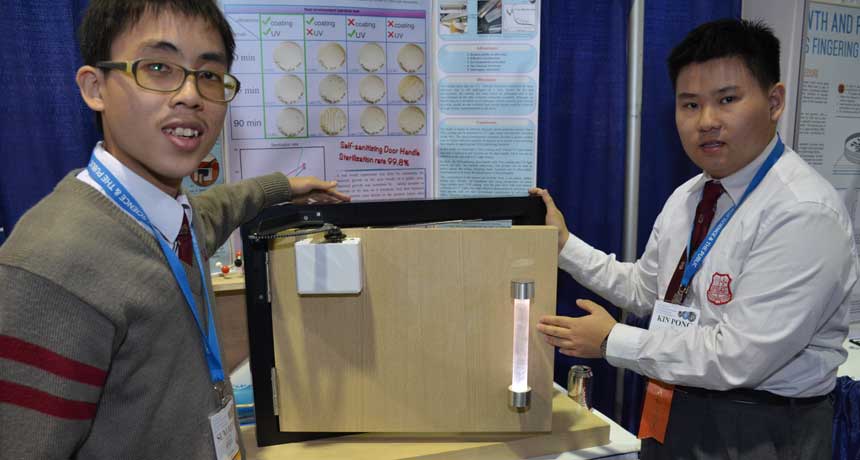This door handle kills germs
UV light, powered by the door’s movement, triggers the microbe-killing power of the handle’s coating

Sum Ming (“Simon”) Wong, 17 (left), and Kin Pong (“Michael”) Li, 18, of Hong Kong show off the self-sanitizing door handle they developed. It’s powered by opening and closing the door.
Laura Buitrago/SSP
By Sid Perkins
PITTSBURGH, Pa. — Diseases spread in many ways. An infected person can cough or sneeze on someone nearby. Or, they can transfer germs through a handshake. But sometimes we pick up germs indirectly. A sick person might leave behind bacteria or viruses when they touch a doorknob, handrail, shopping cart handle or countertop. Anyone else who touches that surface may pick up the microbes. But what if those surfaces could disinfect themselves?
Two teens from Hong Kong asked themselves the same question. Now they’ve developed a door handle that can knock out germs on contact.

Research by others has shown that door handles in public areas often host lots of bacteria and viruses, notes 17-year-old Sum Ming (“Simon”) Wong. The tenth grader attends Church of Christ in China Tam Lee Lai Fun Memorial Secondary School in Tuen Mun, China. He and schoolmate Kin Pong (“Michael”) Li, 18, wanted to design a coating for door handles that would be hostile to germs.
After doing some research, they learned that a mineral called titanium dioxide is known to kill bacteria. It’s already used for other purposes in many products, from paints to sunscreens to edible puddings. To make their coating, the teens ground the mineral into a very fine powder.
Titanium dioxide kills bacteria best when lit by ultraviolet (UV) light, says Simon. UV wavelengths are among those in sunlight. But indoor handles and any used at night would have little natural exposure to UV light. So the teens are lighting their door handle from within. Now, every part of the coated handle will see UV light.
To make sure the interior light reaches the coated surface, the teens fashioned their door handle from a long cylinder of clear glass. Each end fits into a bracket. Inside one of the brackets is a strong light-emitting diode (LED). It emits UV light. (Transmitting the light from one end of the handle to the other is similar to the transmission of light through a fiber-optic cable. In this case, though, the glass handle is fat rather than super-thin.)
And here’s the nifty part: The power that makes the UV light shine comes from opening and closing the door. Simon and Michael designed a small gearbox that attaches to the door. Equipment inside the box converts the motion of those gears into electrical power. That power is then carried by wire to the light-emitting diode inside the door handle.
The teens presented details of their research here at the Intel International Science and Engineering Fair. This event was created by the Society for Science and the Public (which also publishes Science News for Students). The annual competition is sponsored by Intel. This year, it brought 1,702 finalists to Pittsburgh in mid-May from more than 70 countries.
The door handle system, Michael and Simon say, might cost no more than about $13 to build.
Power Words
(for more about Power Words, click here)
bacterium (plural bacteria) A single-celled organism. These dwell nearly everywhere on Earth, from the bottom of the sea to inside animals.
fiber optics The use of thin, flexible fibers of glass (known as optical fibers) or other transparent solids to transmit light signals, chiefly for telecommunications.
germ Any one-celled microorganism, such as a bacterium, fungal species or virus particle. Some germs cause disease. Others can promote the health of higher-order organisms, including birds and mammals. The health effects of most germs, however, remain unknown.
light emitting diodes (LEDs) Electronic components that, as their name suggests, emit light when electricity flows through them. LEDs are very energy-efficient and often can be very bright. They have lately been replacing conventional lights in auto taillights and in some bulbs used for home lighting.
microbe Short for microorganism. It is a living thing that is too small to see with the unaided eye, including bacteria, some fungi and many other organisms such as amoebas. Most consist of a single cell.
mineral The crystal-forming substances, such as quartz, apatite, or various carbonates, that make up rock. Most rocks contain several different minerals mish-mashed together. A mineral usually is solid and stable at room temperatures and has a specific formula, or recipe (with atoms occurring in certain proportions) and a specific crystalline structure (meaning that its atoms are organized in certain regular three-dimensional patterns).
Society for Science and the Public (or SSP) A nonprofit organization created in 1921 and based in Washington, D.C. Since its founding, SSP has been not only promoting public engagement in scientific research but also the public understanding of science. It created and continues to run three renowned science competitions, including the Intel International Science and Engineering Fair (initially launched in 1950). SSP also publishes award-winning journalism in Science News (launched in 1922) and Science News for Students (created in 2003).
titanium dioxide A white, unreactive, solid material that occurs naturally as a mineral and is used extensively as a white pigment.
ultraviolet A portion of the light spectrum that is close to violet but invisible to the human eye.
virus Tiny infectious particles consisting of RNA or DNA surrounded by protein. Viruses can reproduce only by injecting their genetic material into the cells of living creatures. Although scientists frequently refer to viruses as live or dead, in fact no virus is truly alive. It doesn’t eat like animals do, or make its own food the way plants do. It must hijack the cellular machinery of a living cell in order to survive.
wavelength The distance between one peak and the next in a series of waves, or the distance between one trough and the next. Visible light — which, like all electromagnetic radiation, travels in waves — includes wavelengths between about 380 nanometers (violet) and about 740 nanometers (red). Radiation with wavelengths shorter than visible light includes gamma rays, X-rays and ultraviolet light. Longer-wavelength radiation includes infrared light, microwaves and radio waves.







